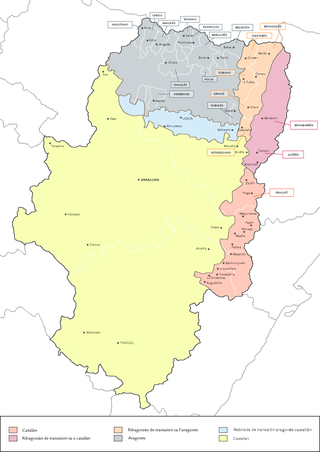
Aragonese is a Romance language spoken in several dialects by about 12,000 people as of 2011, in the Pyrenees valleys of Aragon, Spain, primarily in the comarcas of Somontano de Barbastro, Jacetania, Alto Gállego, Sobrarbe, and Ribagorza/Ribagorça. It is the only modern language which survived from medieval Navarro-Aragonese in a form distinctly different from Spanish.

Benabarre, in Ribagorçan and Aragonese: Benavarri is a town and municipality in the Aragonese comarca of Ribagorza, in the province of Huesca, Spain.
Ribagorçan is a number of Romance dialects spoken in the modern territories of the medieval County of Ribagorza, in northern Spain.

José Antonio Labordeta Subías was a Spanish (Aragonese) singer, songwriter, poet, writer and political activist. He was described by The Gran Enciclopedia Aragonesa 2000 as "The most important Aragonese singer-songwriter". He began singing in an attempt to give more relevance to his poetry; his songs are well-known and beloved anthems in Aragón. Poetic songs such as "Aragón", "Canto a la Libertad" or "Me dicen que no quieres" were also sung all around Spain.

The Senyera is a vexillological symbol based on the coat of arms of the Crown of Aragon, which consists of four red stripes on a yellow field. This coat of arms, often called bars of Aragon, or simply "the four bars", historically represented the King of the Crown of Aragon.

The Crown of Aragon was a composite monarchy ruled by one king, originated by the dynastic union of the Kingdom of Aragon and the County of Barcelona and ended as a consequence of the War of the Spanish Succession. At the height of its power in the 14th and 15th centuries, the Crown of Aragon was a thalassocracy controlling a large portion of present-day eastern Spain, parts of what is now southern France, and a Mediterranean empire which included the Balearic Islands, Sicily, Corsica, Sardinia, Malta, Southern Italy and parts of Greece.

Manchones is a municipality in the province of Zaragoza, Aragon, Spain. According to the Spanish Statistical Institute (INE), the municipality had a population of 123 inhabitants in 2010. The pueblo is in the comarca of Campo de Daroca, about 6 kilometres (3.7 mi) northwest of Daroca and just southeast of Murero in the Calatayud-Daroca depression. The Jiloca River passes to the west.

The so-called Bars of Aragon, Royal sign of Aragon, Royal arms of Aragon, Four Bars, Red Bars or Coat of arms of the Crown of Aragon, which bear four red pallets on gold background, depicts the familiar coat of the Kings of Aragon. It differs from the flag because this latter instead uses bars. It is one of the oldest coats of arms in Europe dating back to a seal of Raymond Berengar IV, Count of Barcelona and Prince of Aragon, from 1150.

The bat is a heraldic symbol sometimes used as a charge, but most prominently used as a crest on or around the crown in municipal arms of the former Crown of Aragon—specifically in Valencia, Catalonia and the Balearic Islands.

The Kingdom of Sobrarbe was the legendary predecessor to the Kingdom of Aragon and the modern region of Sobrarbe. According to the late medieval legend, the kingdom, with its capital at Aínsa, was a product of the Reconquista. The legend is based in part on the historical origins of the Kingdom of Pamplona.

Gualberto Fabricio de Vagad was an Aragonese Cistercian Benedictine monk and the first historian of the Kingdom of Aragon. He was born in Zaragoza in the first third of the fifteenth century and straddles the line between the Late Middle Ages and the Renaissance. He lived most of his life at the monastery of Santa María de Santa Fe, though he also spent some time at San Juan de la Peña. According to Félix de Latassa y Ortín, besides history he wrote various treatises on poetry and a compendium of verse.

Ignacio Jordán Claudio de Asso y del Río was a Spanish diplomat, naturalist, lawyer and historian. He sometimes used the pseudonym of Melchor de Azagra.
The Gran Enciclopedia Aragonesa is a Spanish language, Aragon-themed, encyclopedia.

Sierra de San Just is a mountain range in the Cuencas Mineras comarca of Aragon, Teruel Province, Spain. The highest point in the range is San Just (1,522 m). This range is located in one of the coldest and most rugged regions of Aragon.

Sierra de Vicort, also known as Sierra de Vicor, is a 20 km (12 mi) long mountain range in the Comunidad de Calatayud and Campo de Daroca comarcas of Aragon, Spain.
Ana Francisca Abarca de Bolea (1602–1685) was a Spanish writer and poet born in Zaragoza on 19 April 1602 and died in Casbas (Huesca) around 1685.

Escors or de Cors, is a family name of French origin probably from the region of Aquitaine or Gascony that moved to Navarre "Escors" is related to other Occitan surnames from Aquitaine and present-day Catalonia that derived form "Cors-Cortis". The name "Cors" permanently incorporated the Occitan medieval demonstrative article "Es-" between the 10th and 12th centuries. Many typographic variants can be found in the documents of the Kingdom of Navarre, or in the Gascon Rolls.

Pablo Hurus was a German printer of the late 15th-century, active in Zaragoza, Aragon during the years 1484 to 1499. With his brother Juan, he established one of the important early printing shops of the Iberian peninsula, predated only by the Sevilla printing shops of Menrad Ungut and Estanislao Polono.
De Aragoniae Regibus et eorum rebus gestis libri V is a chronicle written in Zaragoza in 1509 by Lucio Marineo Siculo documenting the feats of the kings of the Aragonese Renaissance. The chronicle was written in Latin and was later translated into Spanish by Juan de Molina. The Spanish edition was published in Valencia in 1524 under the title Crónica d'Aragón.

Jerónim de Blancas y Tomás, was a Latinist and an influential legal historian active in the Crown of Aragon.

















